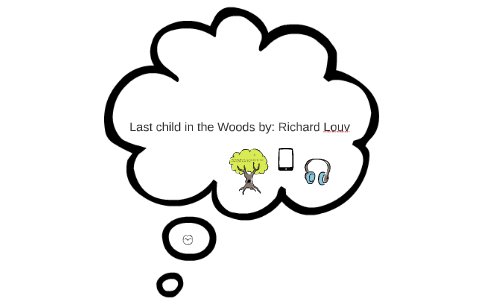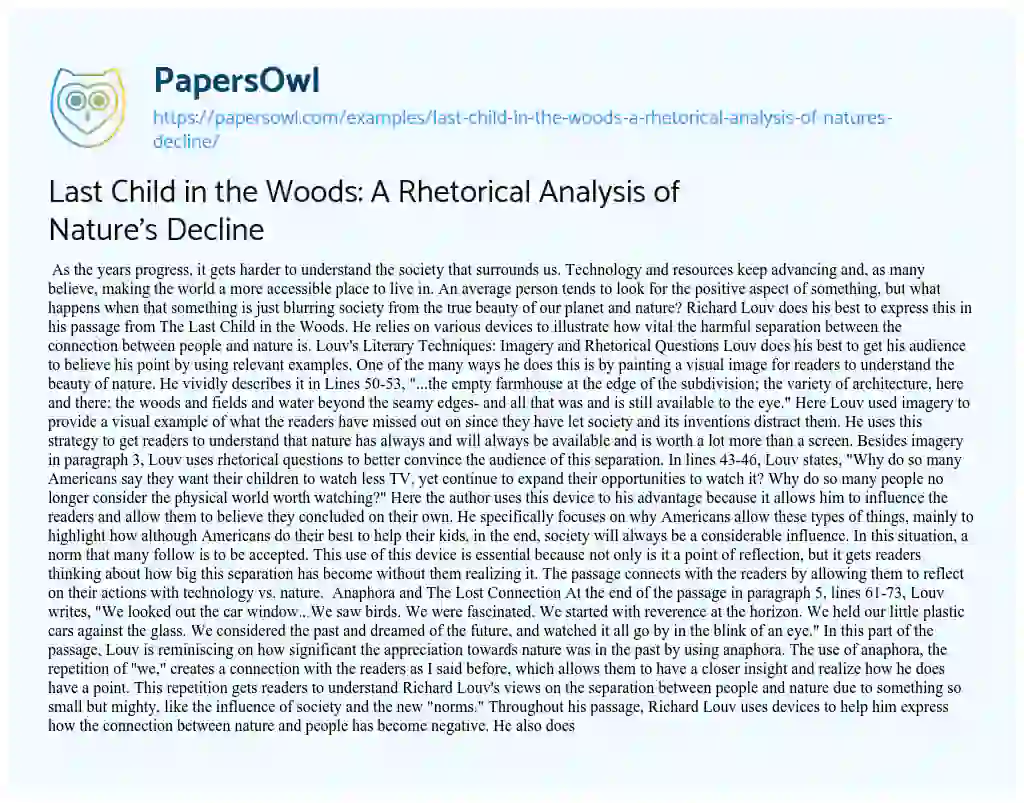NatureDeficit Disorder. The subtitle of Last Child in the Woods is “Saving Our Children from Nature Deficit Disorder”. This term, nature-deficit disorder, was coined by Louv to describe the impact of disappearing natural experiences on our children — and on us. In full disclosure, he points out that it is no way a medical description
Rhetorical Analysis with Last Child in the Woods – YouTube
LAST CHILD IN THE WOODS An Analysis of Nature, Child, and Time through a Lens of Eco-Mindfulness ABSTRACT With the publication of Last Child in the Woods: Saving Our Children from Nature-Deficit Disorder in 2005, Richard Louv introduced the term “nature-deficit disorder” and illuminated children’s physical, mental, and spiritual need for

Source Image: prezi.com
Download Image
successful accomplishment of the purpose. In short, rhetorical analysis means explaining not only what writers are saying but also why and how they are saying it. This year’s analysis question featured a passage from Richard Louv’s Last Child in the Woods that sounds an alarm about the increasing separation between humans and the natural world.

Source Image: elcorteingles.es
Download Image
Books That Teach Figurative Language – The Butterfly Teacher This is a video designed to help students prepare to write a Rhetorical Analysis essay using a College Board AP prompt.

Source Image: pinterest.com
Download Image
Last Child In The Woods Rhetorical Analysis
This is a video designed to help students prepare to write a Rhetorical Analysis essay using a College Board AP prompt. In Last Child in the Woods, Louv uses rhetorical devices to display his thoughts through examples and evidence. These are: technology takes away from our ability to appreciate and indulge in nature, the growing influence of the media on our children, and the influence of visionary on our minds.
39 Best Rhetorical Analysis ideas | rhetorical analysis, rhetoric, funny commercials
Get original essay To continue building off the in-car entertainment anecdote, Louv uses juxtaposition to help him show his disdain towards the idea. He proposes that ‘we’ll someday tell our grandchildren/that there was a time when kids looked out the car window/instead of playing on phones or watching backseat television”. 29 Rhetorical analysis ideas | rhetorical analysis, rhetoric, ap language

Source Image: pinterest.com
Download Image
The Rhetoric | Figures Of Speech – Menonimus Get original essay To continue building off the in-car entertainment anecdote, Louv uses juxtaposition to help him show his disdain towards the idea. He proposes that ‘we’ll someday tell our grandchildren/that there was a time when kids looked out the car window/instead of playing on phones or watching backseat television”.

Source Image: menonimus.org
Download Image
Rhetorical Analysis with Last Child in the Woods – YouTube NatureDeficit Disorder. The subtitle of Last Child in the Woods is “Saving Our Children from Nature Deficit Disorder”. This term, nature-deficit disorder, was coined by Louv to describe the impact of disappearing natural experiences on our children — and on us. In full disclosure, he points out that it is no way a medical description

Source Image: m.youtube.com
Download Image
Books That Teach Figurative Language – The Butterfly Teacher successful accomplishment of the purpose. In short, rhetorical analysis means explaining not only what writers are saying but also why and how they are saying it. This year’s analysis question featured a passage from Richard Louv’s Last Child in the Woods that sounds an alarm about the increasing separation between humans and the natural world.

Source Image: thebutterflyteacher.com
Download Image
Last Child in the Woods: A Rhetorical Analysis of Nature’s Decline – Free Essay Example – 661 Words | PapersOwl.com Richard Louv, a novelist, in Last Child in the Woods (2008) illustrates the separation between humans and nature. His purpose to the general audience involves exposing how the separation of man from nature is consequential. Louv adopts a sentimental tone throughout the rhetorical piece to elaborate on the growing separation in modern times.

Source Image: papersowl.com
Download Image
11 Rhetorical Analysis ideas | rhetorical analysis, rhetoric, ap language and composition This is a video designed to help students prepare to write a Rhetorical Analysis essay using a College Board AP prompt.

Source Image: pinterest.com
Download Image
Rhetorical Analysis Essay-The Last Child in the Woods.docx – Rhetorical Analysis Essay In the passage from the book The Last Child in the Woods | Course Hero In Last Child in the Woods, Louv uses rhetorical devices to display his thoughts through examples and evidence. These are: technology takes away from our ability to appreciate and indulge in nature, the growing influence of the media on our children, and the influence of visionary on our minds.

Source Image: coursehero.com
Download Image
The Rhetoric | Figures Of Speech – Menonimus
Rhetorical Analysis Essay-The Last Child in the Woods.docx – Rhetorical Analysis Essay In the passage from the book The Last Child in the Woods | Course Hero LAST CHILD IN THE WOODS An Analysis of Nature, Child, and Time through a Lens of Eco-Mindfulness ABSTRACT With the publication of Last Child in the Woods: Saving Our Children from Nature-Deficit Disorder in 2005, Richard Louv introduced the term “nature-deficit disorder” and illuminated children’s physical, mental, and spiritual need for
Books That Teach Figurative Language – The Butterfly Teacher 11 Rhetorical Analysis ideas | rhetorical analysis, rhetoric, ap language and composition Richard Louv, a novelist, in Last Child in the Woods (2008) illustrates the separation between humans and nature. His purpose to the general audience involves exposing how the separation of man from nature is consequential. Louv adopts a sentimental tone throughout the rhetorical piece to elaborate on the growing separation in modern times.